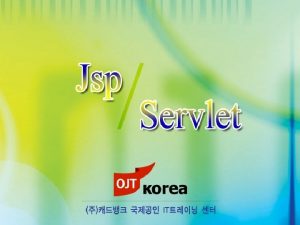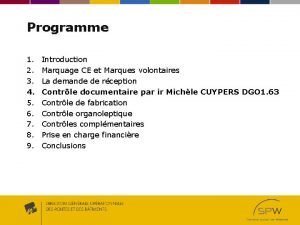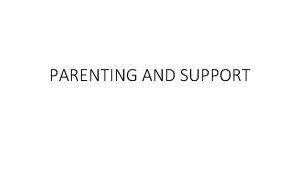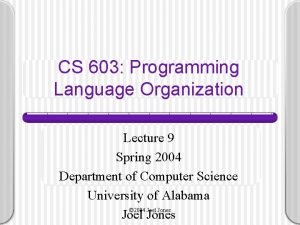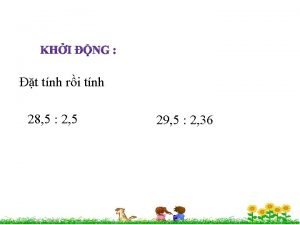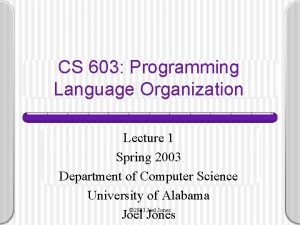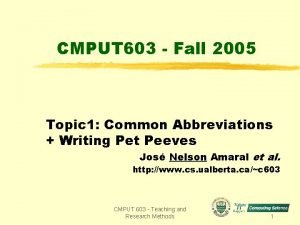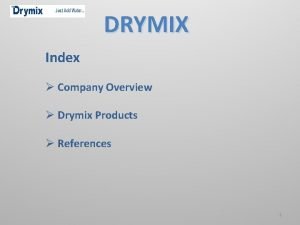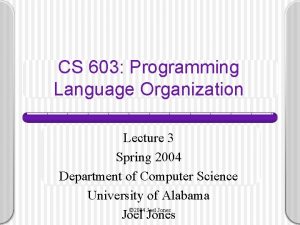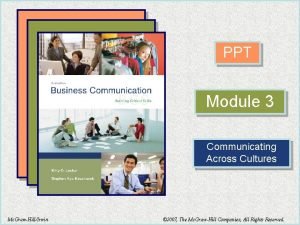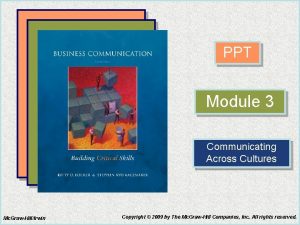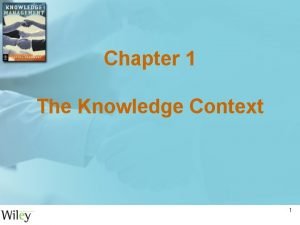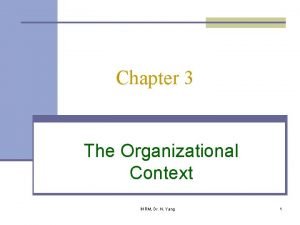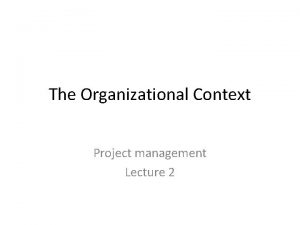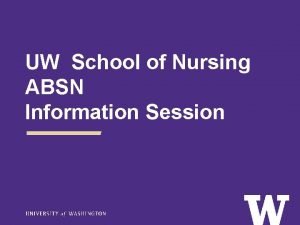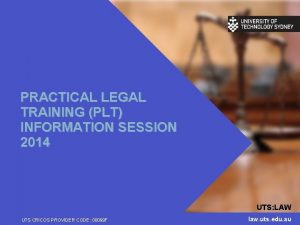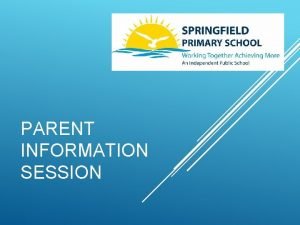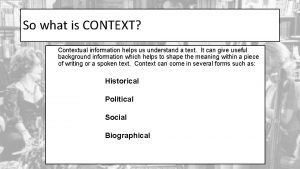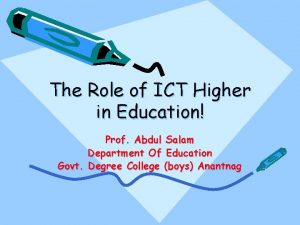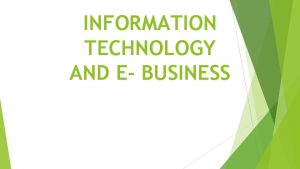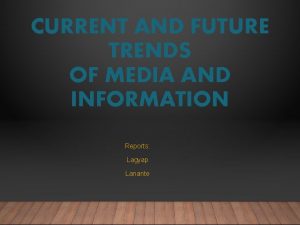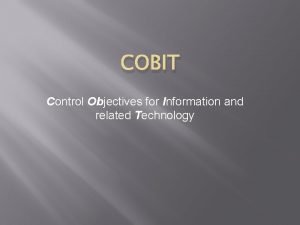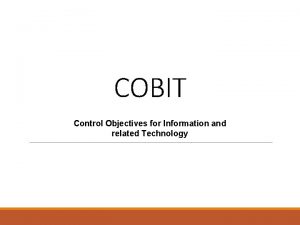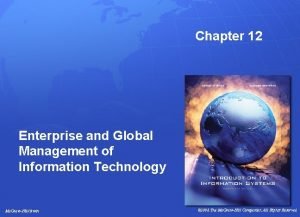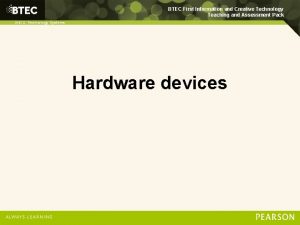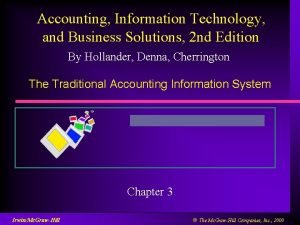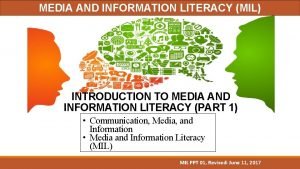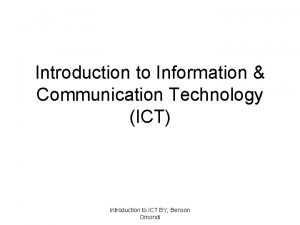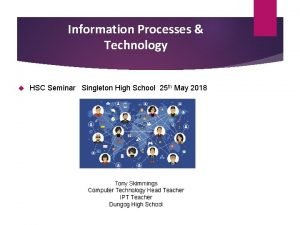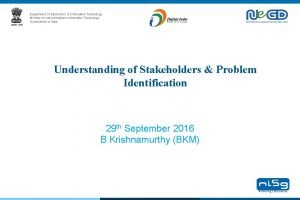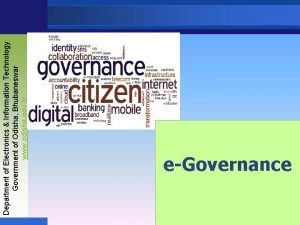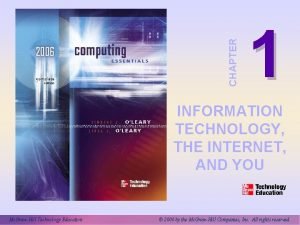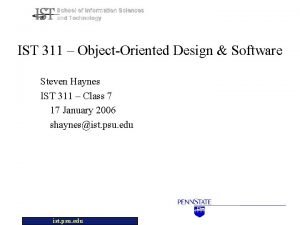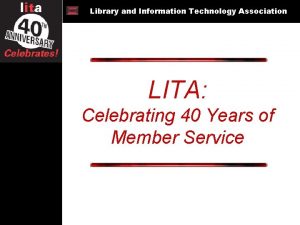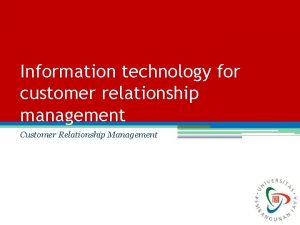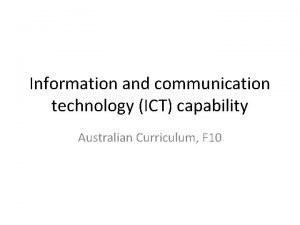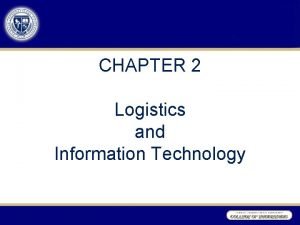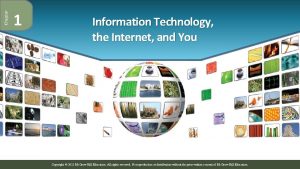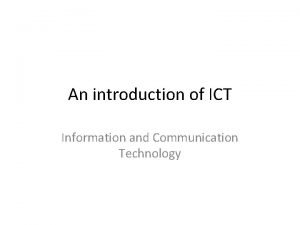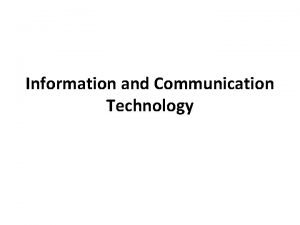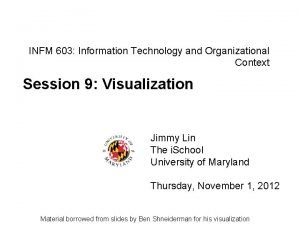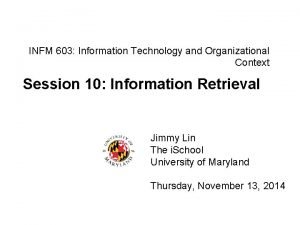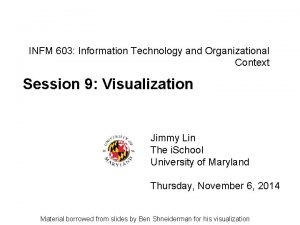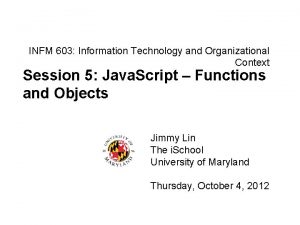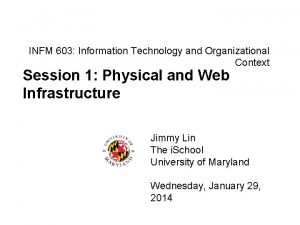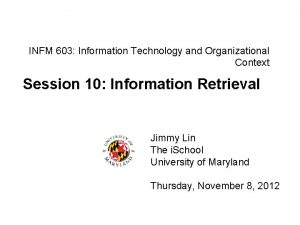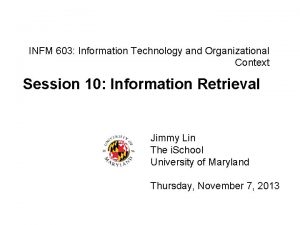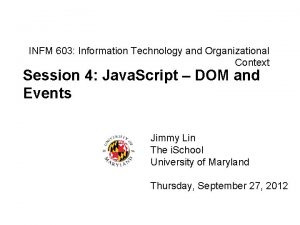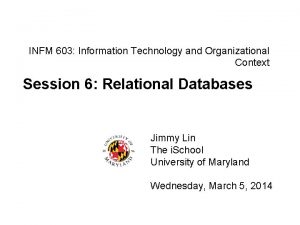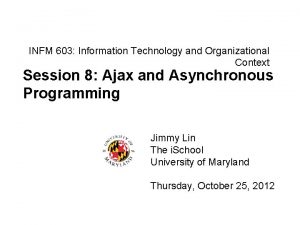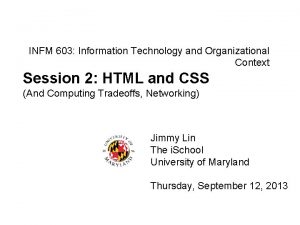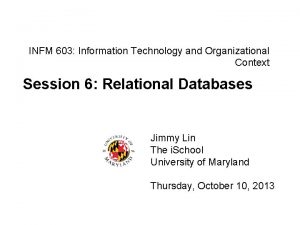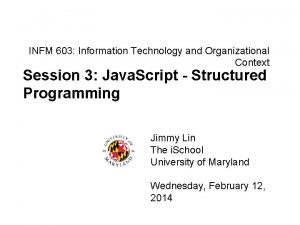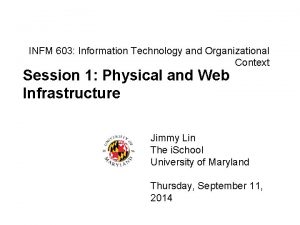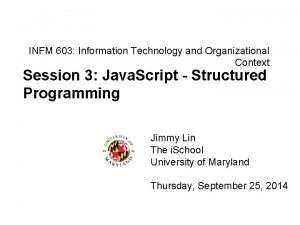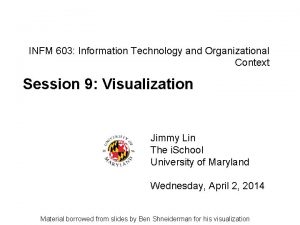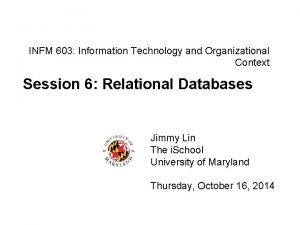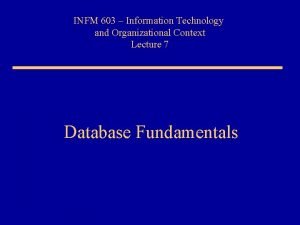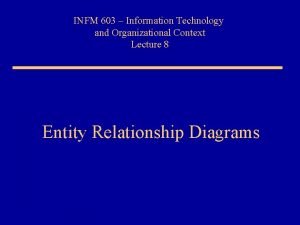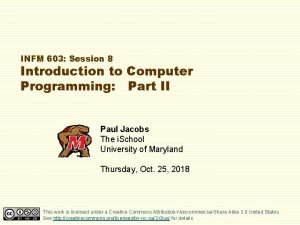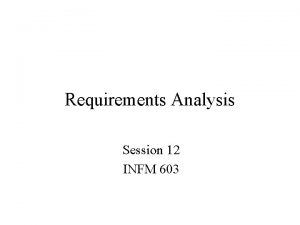INFM 603 Information Technology and Organizational Context Session















































- Slides: 47

INFM 603: Information Technology and Organizational Context Session 13: Developing and Managing Technology Jimmy Lin The i. School University of Maryland Wednesday, April 30, 2014

The Technology Lifecycle ¢ How do you know what to build? ¢ How do you actually build it? ¢ How do you keep it running? It’s about asking the right questions!

First Things First ¢ What’s already there? ¢ Do users actually want it? ¢ Is technology even the right answer? ¢ What’s the use context? Technology is for solving problems!

How do you know what to build? ¢ Ask your users ¢ Watch them


So you’re going to build technology…

Major Decisions ¢ Build vs. buy ¢ In-house vs. out-source ¢ Open source vs. proprietary ¢ Best of breed vs. integrated solution Pick your poison

Architecture Choices ¢ Desktop software ¢ Web app l l ¢ Hosted in the cloud? In-house datacenter? Mobile app Advantages and disadvantages to each!

Requirements ¢ Functionality ¢ Latency and throughput ¢ Capacity ¢ Reliability and resiliency ¢ Flexibility ¢ Development cost and time

There’s no free meal!

Software Development Source: Wikipedia (ENIAC)

The Waterfall Model ¢ Key idea: upfront investment in design l ¢ An hour of design can save a week of debugging! Five stages: l l l Requirements: figure out what the software is supposed to do Design: figure out how the software will accomplish the tasks Implementation: actually build the software Verification: makes sure that it works Maintenance: makes sure that it keeps working

The Waterfall Model Requirements Design Implementation Verification Maintenance


The Spiral Model ¢ Build what you think you need l ¢ Get a few users to help you debug it l ¢ First an “alpha” release, then a “beta” release Release it as a product (version 1. 0) l ¢ Perhaps using the waterfall model Make small changes as needed (1. 1, 1. 2, …. ) Save big changes for a major new release l Often based on a total redesign (2. 0, 3. 0, …)

The Spiral Model 1. 2 2. 3 0. 5 1. 1 1. 0 2. 0 3. 0 2. 1 2. 2

Unpleasant Realities ¢ The waterfall model doesn’t work well l ¢ Requirements usually incomplete or incorrect The spiral model is expensive l Redesign leads to wasted effort

Prototyping ¢ What’s the purpose of the prototype? l l Meant to explore requirements, then be thrown away An initial version of the software to be subsequently refined ¢ Both are fine, as long as the goal is clear ¢ Be aware, interfaces can be deceiving

SCRUM ¢ An agile development methodology: the “fashion” today ¢ As with any methodology… l l l Don’t blindly follow processes Understand the rationale behind them Adapt them to your context

Key Concepts ¢ Roles: l l l ¢ Product owner: voice of the customer Development team: small team software engineers Scrum master: primary role as facilitator User stories: short non-technical description of desired user functionality l l “As a user, I want to be able to search for customers by their first and last names” “As a site administrator, I should be able to subscribe multiple people to the mailing list at once”

Basic SCRUM Cycle ¢ The sprint: l l l ¢ Basic unit of development Fixed duration (typically one month) End target is a working system (not a prototype) Sprint planning meeting l l Discussion between product owner and development team on what can be accomplished in the sprint Sprint goals are owned by the development team

Standup Meetings ¢ Short, periodic status meetings (often daily) ¢ Three questions: l l l What have you been working on (since the last standup)? What are you planning to work on next? Any blockers?

SCRUM

Advantages of SCRUM ¢ Fundamentally iterative, recognizes that requirements change ¢ Development team in charge of the sprint backlog l l ¢ Time-limited sprints ensure periodic delivery of new product increments l ¢ Favors self-organization rather than top-down control Reprioritize in response to changing requirements and progress Allows opportunities to receive user feedback, change directions, etc. Buzzword = velocity

Disadvantages ¢ Can be chaotic ¢ Dependent on a good SCRUM master to reconcile priorities ¢ Requires dedication of team members ¢ Slicing by “user stories” isn’t always feasible

Keeping Technology Runnin

Management Issues ¢ Operating costs l l ¢ Retrospective conversion l l ¢ Staff time Physical resources (space, cooling, power) or the cloud Periodic maintenance Equipment replacement Moving from “legacy systems” Even converting electronic information is expensive! Incremental improvements l Upgrade path?

Management Issues ¢ Usage information l l ¢ Usage logs, audit trails, etc. Collection, storage, as well as analysis Training l l Staff Users ¢ Privacy, security, access control ¢ Backup and disaster recovery l l Periodicity, storage location The cloud doesn’t necessarily solve all the issues Remember Murphy’s Law!

TCO ¢ “Total cost of ownership” ¢ Hardware and software aren’t the only costs! ¢ Other (hidden) costs: all the issues discussed above

What is open source? ¢ Proprietary vs. open source software ¢ Open source used to be a crackpot idea: l l ¢ Bill Gates on Linux (3/24/1999): “I don’t really think in the commercial market, we’ll see it in any significant way. ” MS 10 -Q quarterly filing (1/31/2004): “The popularization of the open source movement continues to pose a significant challenge to the company’s business model” Open source… l l For tree hugging hippies? Make love, not war?

Basic Definitions ¢ What is a program? An organized list of instructions that, when executed, causes the computer to behave in a predetermined manner. Like a recipe. ¢ What is source code? Program instructions in their original, human-readable form. ¢ What is object/executable code (binaries)? Program instructions in a form that can be directly executed by a computer. A compiler takes source code and generates executable code.

Proprietary Software ¢ Distribution in machine-readable binaries only ¢ Payment for a license l l ¢ Grants certain usage rights Restrictions on copying, further distribution, modification Analogy: buying a car… l l l With the hood welded shut That only you can drive That you can’t change the rims on

Open Source Principles ¢ Free distribution and redistribution l “Free as in speech, not as in beer” “The license may not restrict any party from selling or giving away the software as a component of an aggregate software distribution containing programs from several different sources. The license may not require royalty or other fee for such sale. ” ¢ Source code availability “The program must include source code, and must allow distribution in source code as well as compiled form”. ¢ Provisions for derived works “The license must allow modifications and derived works, and must allow them to be distributed under the same terms as the license of the original software. ”

Open Source vs. Proprietary ¢ Who gets the idea to develop the software? ¢ Who actually develops the software? ¢ How much does it cost? ¢ Who can make changes?

Examples of Open Source Software Proprietary Open Source Operating system Windows Linux Office suite Microsoft Office Open. Office Image editor Photoshop GIMP Web browser Internet Explorer Mozilla Web server IIS Apache Database Oracle My. SQL

Open Source: Pros ¢ Peer-reviewed code ¢ Dynamic community ¢ Iterative releases, rapid bug fixes ¢ Released by engineers, not marketing people ¢ No vendor lock-in ¢ Simplified licensed management

Pros in Detail ¢ Peer-reviewed code l l ¢ Everyone gets to inspect the code More eyes, fewer bugs Dynamic community l l Community consists of coders, testers, debuggers, users, etc. Any person can have multiple roles Both volunteers and paid by companies Volunteers are highly-motivated

Pros in Detail ¢ Iterative releases, rapid bug fixes l l l ¢ Anyone can fix bugs Bugs rapidly fixed when found Distribution of “patches” Released by engineers, not marketing people l l Stable versions ready only when they really are ready Not dictated by marketing deadlines

Pros in Detail ¢ No vendor lock-in l l l ¢ Lock in: dependence on a specific program from a specific vendor Putting content in MS Word ties you to Microsoft forever Open formats: can use a variety of systems Simplified licensed management l l l Can install any number of copies No risk of illegal copies or license audits No anti-piracy measures (e. g. CD keys, product activation) No need to pay for perpetual upgrades Doesn’t eliminate software management, of course

Cons of Open Source ¢ Dead-end software ¢ Fragmentation ¢ Developed by engineers, often for engineers ¢ Community development model ¢ Inability to point fingers

Cons in Detail ¢ Dead-end software l l ¢ Development depends on community dynamics: What happens when the community loses interest? How is this different from the vendor dropping support for a product? At least the source code is available Fragmentation l l Code might “fork” into multiple versions: incompatibilities develop In practice, rarely happens

Cons in Detail ¢ Developed by engineers, often for engineers l l ¢ Community development model l l ¢ My favorite “pet feature” Engineers are not your typical users! Cannot simply dictate the development process Must build consensus and support within the community Inability to point fingers l l Who do you call up and yell at when things go wrong? Buy a support contract from a vendor!


Open Source Business Models ¢ Support Sellers Give away the software, but sell distribution, branding, and after-sale service. ¢ Loss Leader Give away the software as a loss-leader and market positioner for closed software. ¢ Widget Frosting If you’re in the hardware business, giving away software doesn’t hurt you and has it’s advantages. What are they? ¢ Accessorizing Sell accessories: books, compatible hardware, complete systems with open-source software pre-installed, and merchandise (open-source T-shirts, coffee mugs, Linux penguin dolls, etc. ).

The TCO Debate

Is open source right for you? ¢ Depends

Questions?
 Context session
Context session Example of presupposition
Example of presupposition 603 550 israelites
603 550 israelites Groutex 603
Groutex 603 750 ilcs 5/603
750 ilcs 5/603 603 keno
603 keno Cs 603
Cs 603 Tìm số dư của phép chia 218 3 7
Tìm số dư của phép chia 218 3 7 Cs 603
Cs 603 Cmput 603
Cmput 603 Maxit 603
Maxit 603 Cs 603
Cs 603 High context vs low context culture ppt
High context vs low context culture ppt High context vs low context culture ppt
High context vs low context culture ppt Contoh high context culture
Contoh high context culture Context and technology-specific knowledge
Context and technology-specific knowledge Organisational context of ihrm
Organisational context of ihrm The organizational context in project management
The organizational context in project management Aka graduate mip
Aka graduate mip Uw absn information session
Uw absn information session Uts student admin
Uts student admin Bomber traverse
Bomber traverse Parent information session
Parent information session The use of contextual information helps us to:
The use of contextual information helps us to: Conclusion for ict
Conclusion for ict Similarities of media information and technology literacy
Similarities of media information and technology literacy Information technology introduction
Information technology introduction Current and future trends of media and information
Current and future trends of media and information Control objectives for information and related technology
Control objectives for information and related technology Control objectives for information and related technology
Control objectives for information and related technology Enterprise and global management in mis
Enterprise and global management in mis Btec first engineering teaching and assessment pack
Btec first engineering teaching and assessment pack Accounting information technology and business solutions
Accounting information technology and business solutions Site:slidetodoc.com
Site:slidetodoc.com An act of transmitting messages
An act of transmitting messages Hsc multiple choice generator
Hsc multiple choice generator Ministry of electronics and information technology
Ministry of electronics and information technology Latest electronic and information technology in odisha
Latest electronic and information technology in odisha Information technology the internet and you
Information technology the internet and you College of information sciences and technology
College of information sciences and technology Library and information technology association
Library and information technology association Information technology and customer relationship management
Information technology and customer relationship management Information and communication technology capability
Information and communication technology capability Logistics and information technology
Logistics and information technology Chapter 1 information technology the internet and you
Chapter 1 information technology the internet and you Introduction to ict
Introduction to ict Information technology pros and cons
Information technology pros and cons Ictmeaning
Ictmeaning
